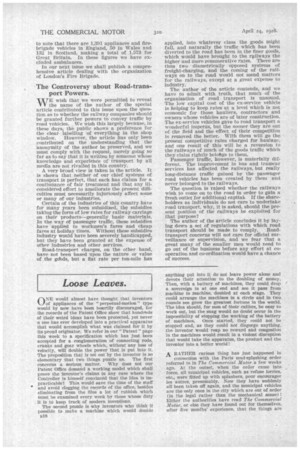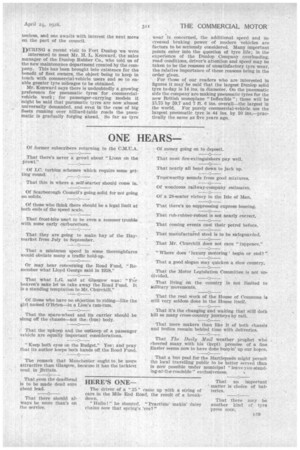Loose Leaves.
Page 44

Page 45

If you've noticed an error in this article please click here to report it so we can fix it.
ONE would almost have thought that inventors of appliances of the "perpetual-motion" type would by now have been heartily discouraged, for the reeords of the Patent Office show that hundreds of their weird ideas have been protected, yet never a one has ever developed into a practical apparatus that would accomplish what was claimed for it by its proud originator. We refer in our " Patent " page this week to a specification which has just been accepted for a conglomeration of connecting rods, cranks and gear wheels which, without any loss of velocity, will double the power that is put into it. The proposition that is set out by the inventor is so elementary that two things puzile us. The first concerns a serious matter. Why does not our Patent Office demand a working model which shall prove the inventor's claims in any case where the Controller is himself convinced that the idea is im
practicable? This would save the time of the staff • and avoid clogging the records of the office, besides eliminating from the files a lot of rubbish which must, he examined every week by those whose duty it is tO keep track of modern inventions.
The second puzzle is why inventors who think it possible to make a machine which would double BIS
anything put into it do not leave power alone and devote their attention to. the doubling of money. Then, with a battery of machines, they could drop a sovereign in at one end and see it pass from machine to machine, doubled at each stage. They could arrange the machines in a circle and in two rounds see grow the greatest fortune in the world. -The idea should, for men of their calibre, be easy to work out, but the snag would no doubt occur in the impossibility of stopping the working of the battery of machines. Once started, they could not be stopped and, as they could not disgorge anything, the inventor would reap no reward and congestion in the machines would result in a violent disruption that would take the apparatus, the product and the inventor into a better world!
A RATHE' 11. curious thing has just happened in
connection with the Paris mud-splashing order referred to in The Commercial Motor 'a few weeks ago. At the outset, when the order came into force, all municipal vehicles, such as refuse lorries, etc., were fitted up with splashers, pour encourager les autres, presumably. Now they have suddenly all been taken off again, and the municipal vehicles are the only ones in the city which are out of order (in the legal rather than the mechanical sense) Either the authorities have read The Commercial Motor, or else they have found out for themselves, after five months' experience, that the things are useless, and one awaits with interest the next move on the part of the council.
DURING a recent visit to Fort Dunlop we were interested to meet Mr. H. L. Kenward, the sales managerof the Dunlop Rubber Co., who told us of the new maintenance department created by the coinpany. This has been brought into existence for the benefit of fleet owners,.the object being to keep in touch with commercial-vehicle users and so to enable greater tyre mileages to be obtained.
Mr. Kenward says there is undoubtedly a growing preference for pneumatic tyres • for commercialvehicle work; for passenger-carrying models it might be said that pneumatic tyres are now almost universally demanded, and even in the case of big fleets running over billiard-table roads the pneumatic is gradually forging ahead. So far as tyre wear is concerned, the additional speed and in. creased braking power of modern Vehicles are factors to be seriously considered. Many important points enter into the question of tyre life; in the experience of the Dunlop Company overloading, road conditions, driver's attention and speed may be taken to be the reasons of unsatisfactory tyre wear, the relative importance of these reasons being in the order given.
Forthose of our readers who are interested in figures it may be said that the largest Dunlop solid tyre to-day is 14 ins, in diameter. On the pneumatic side the company are making pneumatic tyres for the new British monoplane " Inflexible "; these will be 15.75 by 59.7 and 7 ft. 6 ins, overall—the largest in the world. For purely commercial-vehicle use the largest pneumatic tyre is 44 ins. by 10 ins.—practically the same as five years ago..




















































































































